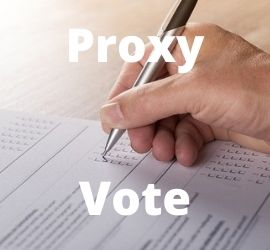What Is a Proxy Vote?
 A proxy vote is a ballot cast by a delegate or representative on behalf of the original vote-holder known as the principal.
A proxy vote is a ballot cast by a delegate or representative on behalf of the original vote-holder known as the principal.
A representative or firm can cast a proxy vote on behalf of the original vote-holder or principal. The principal is often a shareholder in a publicly traded corporation who may not be able to attend the shareholder meeting, or who may not choose to vote on a particular issue. The appointed representative is known as the proxy or proxy voter.
When you buy a stock, you become a part business owner of that company. Proxy voting allows shareholders to influence company operations and decisions. It’s the primary way that shareholders have a say in how public companies around the world are governed. The issues at stake in many proxy votes typically focus on the long-term benefits to a company. This makes the process that much more relevant for investors and traders.
Shareholders receive a proxy ballot in the mail along with an information booklet called a proxy statement. The statement describes the issues to be voted on during the meeting. Shareholders typically vote on various issues, including the election of board members, mergers, or acquisition approvals.
Mutual funds are investment companies and investing in shares of a mutual fund makes you a shareholder of the fund. As a shareholder, you are entitled to vote on matters presented at a fund’s shareholder meeting. Registered investment management companies may also cast proxy votes on behalf of mutual fund shareholders or high net worth investors in separately managed accounts.
Proxy Vote – A Closer Look
Publicly traded companies are required by law to report to shareholders. They do this through a variety of means, most notably by inviting shareholders to an annual meeting. Before the annual meeting, shareholders are sent documents known as proxy statements. This includes details about the annual meeting, share ownership, board structure, executive compensation. In short, all the pertinent issues for consideration and voting at the annual meeting. Investors who own voting shares in the company as of the company’s record date may be eligible to vote on these issues. The company will typically make proxy materials available online and through mailed information packets. Information typically includes an annual report, a proxy statement describing the issues to be voted on, and a proxy card with voting instructions.
Rather than physically attending the shareholder meeting, investors may elect someone else to vote in their place, such as a member of the company’s management team. This person is designated as a proxy and will cast a proxy vote in line with the shareholder’s directions as written on their proxy card. Proxy votes may be cast by mail, phone, or online before the cutoff time. This is typically 24 hours before the shareholder meeting. Responses may include “For,” “Against,” “Abstain,” or “Not Voted.” For issues involving topics other than electing directors, such as voting on shareholder proposals, a majority of the votes is what typically leads to approval of the issue. (Source: investopedia.com)
Plurality vs Majority Voting
Sometimes a plurality vote is used when a company elects its board of directors. Other times, decisions are made using a majority voting system.
- Plurality vote – The winning candidate simply needs more votes than their competitor in a plurality vote. Therefore, an unopposed director only needs one vote to be elected. If shareholders are opposed to the candidate, they may withhold their voting rights.
- Majority vote – In other instances, decisions are made based on a majority voting system. When a majority vote applies, directors need to receive a majority of the votes to be elected. Abstaining from voting can impact whether or not a director is elected. Therefore, the company’s proxy statement must detail how abstained or withheld votes will affect the voting results.
Examples of a Proxy Vote
Kirkland Lake Gold, 2019 – On Nov. 25, 2019, Kirkland Lake Gold (KL) announced that it intended to acquire Detour Gold in an all-stock deal. The two companies would merge to become one company. Kirkland Lake Gold shareholders would own roughly 73% of the resulting company. The remaining 27% ownership would go to the shareholders of Detour Gold. The board members of each company unanimously approved the deal. Nevertheless, shareholders were still eligible to vote on the acquisition, so all eligible shareholders received voting and proxy information. Per the instructions, shareholders were informed that they could cast their own ballot or appoint someone else to do it for them. The deal was completed in January 2020. As a result of the deal, Detour Gold shares were delisted in February 2020. The company became a subsidiary of Kirkland Gold. (Source: ibid)
Proctor & Gamble, 2017 – According to Fortune, the largest instance of a proxy fight occurred in 2017. It happened when some Proctor & Gamble shareholders wanted to give activist investor Nelson Peltz a seat on the board. However, the company management was strongly opposed to that happening. Peltz wrote a lengthy analysis outlining changes he wanted to see at the company. He then used a proxy solicitation company to reach all shareholders with his message. However, in the end, the shareholders voted to deny Peltz a board seat. (Source: corporatefinanceinstitute.com)
Up Next: What Is a Zero-Sum Game?
 In a zero-sum game, one person’s gain causes another person to lose an equal amount. For everyone involved, the net change is zero.
In a zero-sum game, one person’s gain causes another person to lose an equal amount. For everyone involved, the net change is zero.
The stock market, in the long run, is not a zero-sum game. There is real and actual wealth creation from economic growth in the stock market.




